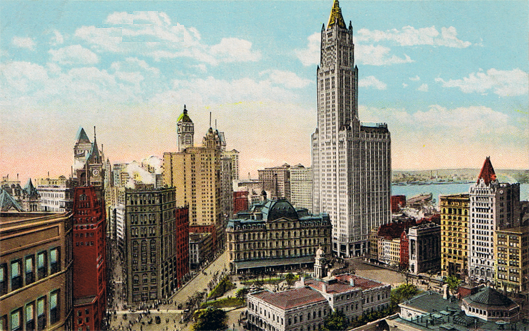Optimism as a Default Setting
Courtesy of Joshua M Brown
“The man who is a bear on the future of the United States will always go broke.”
– J.P. Morgan
We begin with a story from one hundred years ago…
From My Favorite J.P. Morgan Story by Mark Skousen:
In the early days of the Twentieth Century, when J.P. Morgan ruled Wall Street, a visitor came to the City. He was a long-time friend of Morgan, a commodity trader from Chicago. He was what might be called a “perma bear” following the Panic of 1907. No matter how high or low the stock market went, his outlook was pessimistic. Another crash, panic and depression were just around the corner.
This was his first visit to the world’s greatest city. He arrived at 23 Wall Street, and was ushered into J.P.’s spacious office overlooking the Exchange on one side and George Washington’s statue on the other.
They immediately began talking about the markets, Morgan being bullish as ever, and his commodity friend being as bearish as ever. “J.P.,” he said, “the news overseas doesn’t look too good.”
“A buying opportunity!” responded Morgan.
After an hour of friendly disputing about the markets, Morgan invited his guest to join him for lunch. They walked outside and started moving up toward Broadway. As they did so, his friend couldn’t help but admire the skyscrapers that dotted the Manhattan horizon. Morgan gave him a tour of the giant buildings, pointing out the Singer Building, the Woolworth Building across from City Hall, the famous three-sided Flatiron Building, and the recently completed Met Life Tower, rising 50 stories high, the tallest skyscraper in the world at the time.
His friend was duly impressed. He said he had never seen anything like it, not even in Chicago.
Finally, J.P. Morgan stopped his friend and said, “Funny thing about these skyscrapers – not a single one was built by a bear!”
Josh here – count the perma bears on the Forbes 400 list or the amount of pessimists who run companies in the Fortune 500. You will find none.
Six years before the above anecdote took place, J.P. Morgan had completed his purchase of Andrew Carnegie’s entire steel operation for the unheard-of sum of $480 million, hundreds of billions in today’s dollars. You don’t do that deal and amass that kind of wealth with a persistently negative outlook. Winners and men and women of foresight and ambition do monumental things, pessimists watch them from the sidelines making a list of all the reasons things won’t work out.
The losers do get to win sometimes, too. But their victories tend to be Pyrrhic, as every calamity ultimately leads to opportunity when the dust clears.
I saw Sam Zell speak to an audience of real estate investors and developers in Manhattan sometime in 2009. He told us that “kings will be made” in this moment. He had nothing left to sell anyone, having blown out of his massive real estate holdings just three years earlier in a time of massive optimism. Old Sam’s seen too many of these cycles, he knows that you always bet on positive outcomes and you bet heavily when you’re alone on that side of the trade. It doesn’t always work but it mostly does.
Pessimism is intellectually seductive and the arguments always sound smarter, especially when they dovetail with our own worries. You think this period is more frightening than the sixteen month recession between July 1981 and November 1982 only because you weren’t there and you haven’t studied history. Your frame of reference is here and now, not then – with a 14% unemployment rate and 15% inflation. As Peter Lynch reminds us about that era, “Sensible professionals wondered if they should take up hunting and fishing, because soon we’d all be living in the woods, gathering acorns. Then the moment of greatest pessimism, when 8 out of 10 swore we where heading into the 1930s the stock market rebounded with a vengeance and suddenly all was right with the world.”
That’s what usually happens.
Nobody should be a “perma” anything. But if you must err to one side or the other, as a default setting of sorts, the right way to lean is obvious.
***
I originally published this piece on April 28th, 2013. A few weeks later, the S&P 500 finally had broken above its prior peak levels from 2000 and 2007, ushering in the current secular bull market we have been in for six and a half years now. Lots of snarky responses to this when I put it out, “Oh look what Josh Brown just wrote, this is the top.”
I inform you of this before the kneejerk reaction to someone being optimistic takes hold in your gut and you feel compelled to label this republishing a top-tick as well. Don’t be that guy (it’s always a guy).
Having optimism as a baseline is a good way of going through life, especially if you’re an investor, an entrepreneur or just generally want to have friends and support a family. However it does not rule out the need for realism and cynicism, which have their place as well. Balance!
Read Also:
No One Wants to Follow a Pessimist (A Wealth Of Common Sense)

By H. Finkelstein & Son, published US pre-1920 – http://commons.wikimedia.org/wiki/File:Woolworth_Building_and_City_Hall_Park,_New_York_City_1910s.png, Public Domain, https://commons.wikimedia.org/w/index.php?curid=20662146




